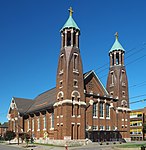Saint Agnes High School (Saint Paul, Minnesota)
1888 establishments in MinnesotaAC with 0 elementsCatholic secondary schools in MinnesotaEducational institutions established in 1888High schools in Saint Paul, Minnesota ... and 3 more
Private elementary schools in MinnesotaPrivate middle schools in MinnesotaRoman Catholic Archdiocese of Saint Paul and Minneapolis
Saint Agnes High School is a private, Roman Catholic high school in Saint Paul, Minnesota, United States. It is located in the Roman Catholic Archdiocese of Saint Paul and Minneapolis, and is affiliated with the Church of St. Agnes in Saint Paul.
Excerpt from the Wikipedia article Saint Agnes High School (Saint Paul, Minnesota) (License: CC BY-SA 3.0, Authors).Saint Agnes High School (Saint Paul, Minnesota)
Lafond Avenue, Saint Paul Frogtown
Geographical coordinates (GPS) Address Nearby Places Show on map
Geographical coordinates (GPS)
| Latitude | Longitude |
|---|---|
| N 44.96 ° | E -93.1225 ° |
Address
Lafond Avenue
Lafond Avenue
55104 Saint Paul, Frogtown
Minnesota, United States
Open on Google Maps







